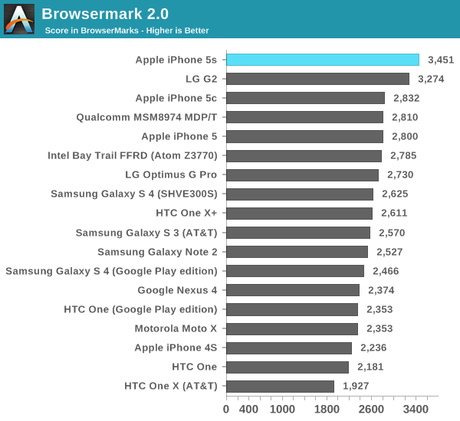When Apple announced the iPhone 5s last week, it made a lot of noise about the 64-bit architecture of the phone’s new A7 chip. But other than that it remained pretty tight-lipped, which is how Apple tends to handle the specific details of individual components. But we have a better understanding, thanks to the chip review site Anandtech, of how the A7 processor powering the iPhone 5s is getting it done with a 1.3GHz dual-core chip.
You read that right. While many smartphone announcements today can feel like a spec arms race, Apple’s dual-core chip sounds positively quaint. But as we’ve seen demonstrated, more cores do not necessarily equal better performance. This holds especially true for the iPhone 5s, which was shown to handily outperform every quad-core Android phone it went up against.
Anandtech pitted the iPhone 5s against leading Android phones from HTC, LG, Motorola and Samsung. LG currently presents the most competition, as its latest flagship phone, the LG G2, uses Qualcomm’s latest quad-core Snapdragon 800 processor clocked at 2.3GHz per core. While it sounds like that chip should have the upper hand against apple’s 1.3GHz dual-core A7, the benchmarks results told a much different story.

In tests for both CPU and GPU performance, the iPhone 5s beat out every phone it was up against — in most instances by quite a large margin. The testing also included Browsermark 2.0, which I’ve used to benchmark phones in the past. It’s a browser benchmark that gives a good view of overall, real-world phone performance. Again, the iPhone 5s came out on top, if not quite as dramatically as in the other tests.
So what makes Apple’s two cores more effective than so many other phones running four? There’s a fairly simple logic to this. Anandtech explained in its review, “Two cores are still better for most uses than four cores running at lower frequencies. Nvidia forced everyone’s hand in moving to 4 cores earlier than they would’ve liked.”
There’s no doubt that four cores (or more) can make for more effective processing. The trick is in making sure these cores are optimized to do the duty. So while you shouldn’t dismiss specs entirely, it wouldn’t hurt manufacturers to take some time to use the four cores they’ve got to the best of their advantage before jumping the gun and going octa-core.
